During the summertime from March to May, the heat in the Philippines becomes unbearable. No wonder the American colonizers in the early 1900s, who weren't used to this kind of heat, looked for a mountain town with a cool climate to develop as a refuge from the tropical fatigue in the lowlands. It was through this that Baguio was developed and declared as the summer capital of the country.
With continuous development, Baguio has become a bustling metropolis and one of the most popular destinations for those who are looking to escape the heat and noise of the lowland cities. Surprisingly, even during the height of the wet season from July to September, the city remains to be a great destination.
If you are planning to visit Baguio, it's best to know a few of the basics. Here's our beginner's guide for travelers to this cool city.
The City
Baguio is situated within the province of Benguet in the Cordillera Administrative Region. It is approximately 57 square kilometers in size and is bounded by the towns of Itogon, Tuba, Sablan, and La Trinidad. Based on census, the city has a population of around 350,000. Common languages spoken are Ibaloi, Kankana-ey, Ifugao, Ilokano, Tagalog, and English.
Historically, Baguio was used as a hunting ground by the indigenous peoples of Cordillera. It became a rancheria during the Spanish colonization. Then the Americans selected it as a hill station and commissioned Daniel Burnham to design it as a beautiful mountain retreat. After which, it was declared a chartered city.
Since then, the city has experienced steady growth and development. Today, apart from being the country's summer capital, Baguio functions as an economic, educational, and tourism hub in Northern Luzon.
How to Get There
Baguio is approximately 250 kilometers north of Manila. There are no direct flights to Baguio. The city's Loakan Airport closed itself from commercial air transport after the airline servicing the Manila to Baguio route stopped its operations in 2009.
Traveling by land is the best option when going to Baguio. Most travelers enter the city via three national roads in the west, namely Kennon Road, Marcos Highway, and Naguilian Road. It can also be accessed from the north and east via Ambuklao Road, Halsema Highway, and the Baguio-Bua-Itogon Road.
From Metro Manila, the most common and the cheapest way to get to Baguio is by bus. The bus ride will take about 6 to 8 hours. Several bus lines ply the Manila to Baguio route. The most popular options are Victory Liner and Genesis Transport. Below are the ticket rates from the usual bus terminals in the metro.
To check the schedules and to book tickets for Victory Liner, visit the site here. For Genesis Transport, contact +63 2 551 0842 or +63 933 852 6856 for schedule and ticket inquiries.
Some larger traveling groups would hire a van going to Baguio. This is a great alternative to taking the bus as the vans are exclusive, air-conditioned, and comfortable. There is also no need for an additional service while in Baguio as it covers general use and tours within the city. Cost of 3 days and 2 nights service range from PHP15,000-20,000 inclusive of a 12-seater van, professional driver, driver meals and accommodation, pick up and drop off in Metro Manila, fuel, toll fees, and taxes.
When to Visit
Baguio has a humid subtropical climate. All throughout the year, the city is blessed with mild temperatures averaging from 17 to 21 degrees Celsius.
The most pleasant travel period for most people is between November and April when clear blue skies are regular and temperatures are colder. But these months are considered high tourist season. Prices of rooms are at its highest and crowds to attractions are at its biggest during this season.
July to September are the wettest months with rain occurring in more than half of the days in a month. It is rather less attractive and considered an off-season for most tourists. This doesn't mean however that these months should be avoided. During this period, there will be lots of accommodation promos and without the crowded attractions and congested locations to contend with.
Where to Stay
There are more than 175 hotels and inns registered to operate in Baguio. As such, visitors to the city have many options, depending on the budget and travel purposes, from affordable no-frills inns to luxurious five-star accommodations.
We stayed at the charming and elegant The Manor at Camp John Hay. The hotel boasts of its luxurious log cabin design and glorious views of pine-covered landscapes and the Cordillera mountains. Situated within the "must-visit" Camp John Hay, The Manor perfectly blends the surrounding beauty with the elements of accessibility, comfort, and warmth.
As we always do, we compare room rates from the hotel website to booking sites like Booking.com. This way we are able to check for the best deals. As the hotel had lean season offers, we booked directly with them. From the full rate of PHP7,845, we were able to get Superior Rooms for only PHP3,975 per night.
Read our review of the hotel: The Manor at Camp John Hay: The Ultimate Getaway in the Mountains of Cordillera
Getting Around Baguio
Since we booked a van service, getting around Baguio was never a problem for us. We would just tell our driver the places we want to visit and the things we want to do and in no time we'll be at our destination. Take note however that parking in Session Road or the market can be quite challenging so make sure to get a driver who is very familiar with Baguio.
Aside from having your own service, there are three other ways of going around the city - riding a jeepney, taking a taxi, or exploring on foot.
Just like anywhere else in the Philippines, riding a jeepney in Baguio is the cheapest option but can be tricky. There are no set schedules or route maps available to the public. So the most important thing to know is the route - where you're at and where you want to go. If unsure, ask the locals as they will be the ones most likely seasoned in commuting around the city. Riding the jeepney can also be inefficient. The process of filling up passengers and stopping every few meters to load or unload can eat up a lot of time in one's itinerary.
Taxis are available 24 hours and can be hailed along any relatively major Baguio street. These are identified with proper markings and white color. The current flag down rate is PHP35 with increments of PHP13.50 per kilometer and PHP2 per minute of travel time. It is not exactly cheap but it is more convenient and faster than riding a jeepney. Also, unlike in Metro Manila, drivers here will give the exact change. Some taxis can also be hired for an entire day of tour.
Walking can also be a great option while in Baguio. It is especially applicable in exploring places near each other. For example, you can walk from Baguio Cathedral to Session Road to Baguio City Market to Burnham Park. You can also walk from Baguio Botanical Garden to Wright Park to The Mansion. In fact, the region's Department of Tourism is also promoting walking in the city through its walk meters installed within the city's major parks. It indicates the distance to key locations and the approximate calories burned walking. It also aims to encourage a car-less community resembling the original plan of the city as a rest and recreation area.
Things to Do
1. Take a mandatory stop at The Mansion
Baguio, being the summer capital, houses a summer residence for the President of the Philippines. Aptly called The Mansion, this has been the official summer residence since the Commonwealth. It is located in the eastern part of the city along Leonard Wood Road.
The Mansion consists of an imposing Spanish Colonial Revival building and guest house. It was designed by William Parsons, the same architect of the Manila Hotel, in accordance with the City Beautiful Movement. Across the road is Wright Park, a quiet promenade with a long reflecting pool lined with pine trees.
Although the property is closed to the public, it is still a mandatory stop for those visiting Baguio. Tourists are satisfied with having souvenir pictures at the elaborate iron gates and the white palatial building as a backdrop.
2. Catch the views at Mines View Park
As they say, you have never been to Baguio if you have not visited the Mines View Park. It might be teeming with tourists and filled with countless souvenir shops but it never gets old and remains a must-visit place.
Located on a land promontory 4 kilometers from the downtown, Mines View Park has an observation deck that offers panoramic views of the Cordillera mountain range, the abandoned gold mines of Benguet Corporation, and glimpses of the Amburayan Valley.
If you happen to have time, try coming in early in the morning. Some claim that Mines View Park offers breathtaking sunrise views over the sea of clouds covering the valley.
3. Take a stroll around Burnham Park
Burnham Park is one of Baguio's beloved spots. It is a historic park located in the heart of the city. It was designed by Daniel Burnham, the original city planner of Baguio and the namesake of the park. It has various gardens and leisure areas interspersed between a man-made lagoon, an athletic bowl, and a grandstand.
Take a leisurely stroll around this beautiful urban oasis and do some recreational activities like boating, skating, or biking.
4. Try the distinct flavor of the Strawberry Taho
Although some say it's overrated, one should still find the opportunity to try Baguio's own version of the Filipino breakfast and snack favorite, the taho. Here, the taho, which is made of silken tofu topped with tapioca pearls, is sweetened with strawberry jam instead of the usual caramelized sugar syrup.
There are taho peddlers in Mines View Park, Burnham Park, and Wright Park. Each cup is sold at PHP20.
5. Experience fun, thrill, and adventure at Tree Top Adventure Baguio
Experience zooming through the jungle canopy of the Cordillera mountains, or simply enjoy the cool Baguio weather as you take in as much of the breathtaking scenery as you can. These are definitely on the menu experience when visiting the Tree Top Adventure Baguio.
Located within Camp John Hay Special Economic Zone, this nature park brings all safety comforts while offering exciting nature tripping activities such as the Canopy Ride, Superman Ride, Silver Surfer, Tree Drop, and Trekking and Skywalk.
Read: High-Flying Fun at Tree Top Adventure Baguio
6. Be awed at the Bencab Museum
Although already located in the neighboring town of Tuba, Bencab Museum is a must in one's Baguio itinerary. It is a museum that is built on a promontory with a breathtaking view of a garden and the surrounding Cordillera mountains.
On the inside, Bencab Museum houses the permanent collection of National Artist for Visual Arts Benedicto Cabrera. The bigger galleries showcase his works ranging from paintings, drawings, prints, and sculptures. The smaller exhibits contain his collections of other local contemporary artists' works. There is also a gallery which houses artifacts and traditional art from all over the Cordillera region.
Read: Things You Won't Want to Miss at the BenCab Museum
7. Go thrift shopping or ukay
Baguio has grown to become an ukay-ukay destination with streets filled with thrift stores left and right. Be warned though that there will be crowds to contend with and piles of old clothing to rummage through in finding rare and beautiful bargains. This may not be exactly an activity for everyone especially those who do not want to put in the work.
But for those who love ukay shopping, wander through the streets of downtown Baguio, hop from rack to rack, and you will find some great little treasures and designer finds to take home.
Where to Eat
With thousands of people flocking to Baguio all year round, naturally, there will also be thousands of food shops and restaurants to cater to the visitors' food cravings. From fine dining restaurants to hole-in-the-wall joints, there is something that will satisfy any taste or budget.
First, try out Le Chef at The Manor, considered as Baguio's best fine-dining restaurant. Reserve a table at the hotel's sprawling gardens to eat good food while enjoying great views and the cool mountain weather.
Next, dine at the homey Forest House, awarded as one of the Philippines' Best Restaurants nine times in the last twelve years. Best known for their comfort food, elevate the dining experience by choosing a table near the fireplace for added warmth from the heat of crackling firewood.
Also drop by Little John's Convenience Outpost, an affordable little nook within Camp John Hay. This place is popular for their baby back ribs and all-day breakfast menu. Get a table at the end of the restaurant to be treated to a nice view. Then grab a crayon and enjoy drawing on recycled paper placemats while waiting for your food to be served.
Lastly, don't miss to visit Choco-Late de Batirol for breakfast or for merienda. It is a garden restaurant characterized as a hodge-podge of wooden artifacts and recycled materials. Best choices would be the Bibingka, Suman sa Lihia, Turon de Langka, and of course, the Choco-Late de Batirol.
Budget
There are a lot of cheap Baguio packages offered by travel agencies with prices starting from as low as PHP1,800 per person. For this trip, however, we went on an exclusive DIY trip and we splurged a bit. We spent approximately PHP4,150 per person for a 2D1N trip inclusive of the hotel stay in The Manor, meals at various restaurants, admission fees to attractions, and the round trip van service.
Note: This guide is designed based on our personal experience and we hope this is of use to Juans who plan to travel for the first time to Baguio.
Are you planning a trip to Baguio? Leave your questions below and we'll try to help out. If you find this useful, please share on social media. Thanks!
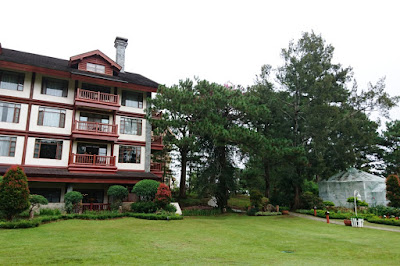 |
| Baguio is a refuge from the tropical heat of the lowlands |
If you are planning to visit Baguio, it's best to know a few of the basics. Here's our beginner's guide for travelers to this cool city.
Baguio is situated within the province of Benguet in the Cordillera Administrative Region. It is approximately 57 square kilometers in size and is bounded by the towns of Itogon, Tuba, Sablan, and La Trinidad. Based on census, the city has a population of around 350,000. Common languages spoken are Ibaloi, Kankana-ey, Ifugao, Ilokano, Tagalog, and English.
Historically, Baguio was used as a hunting ground by the indigenous peoples of Cordillera. It became a rancheria during the Spanish colonization. Then the Americans selected it as a hill station and commissioned Daniel Burnham to design it as a beautiful mountain retreat. After which, it was declared a chartered city.
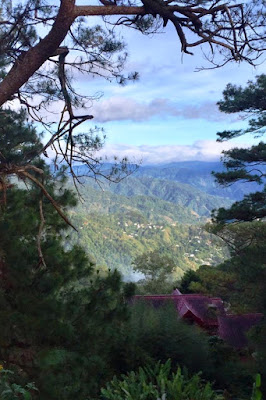 |
| Beautiful views of Baguio on a clear morning |
How to Get There
Baguio is approximately 250 kilometers north of Manila. There are no direct flights to Baguio. The city's Loakan Airport closed itself from commercial air transport after the airline servicing the Manila to Baguio route stopped its operations in 2009.
Traveling by land is the best option when going to Baguio. Most travelers enter the city via three national roads in the west, namely Kennon Road, Marcos Highway, and Naguilian Road. It can also be accessed from the north and east via Ambuklao Road, Halsema Highway, and the Baguio-Bua-Itogon Road.
From Metro Manila, the most common and the cheapest way to get to Baguio is by bus. The bus ride will take about 6 to 8 hours. Several bus lines ply the Manila to Baguio route. The most popular options are Victory Liner and Genesis Transport. Below are the ticket rates from the usual bus terminals in the metro.
Victory Liner
|
|
Route / Service Type
|
Cost in PHP
|
Pasay – Baguio (First Class)
|
800.00
|
Pasay – Baguio (Regular Aircon)
|
496.00
|
Sampaloc – Baguio (Regular Aircon)
|
487.00
|
Cubao – Baguio (Regular Aircon)
|
485.00
|
Genesis Transport
|
|
Route / Service Type
|
Cost in PHP
|
Pasay – Baguio (JoyBus Premier)
|
760.00
|
Pasay – Baguio (JoyBus Deluxe)
|
730.00
|
Pasay – Baguio (Regular Aircon)
|
485.00
|
Cubao – Baguio (JoyBus Premier)
|
740.00
|
Cubao – Baguio (JoyBus Deluxe)
|
720.00
|
Cubao – Baguio (Regular Aircon)
|
475.00
|
To check the schedules and to book tickets for Victory Liner, visit the site here. For Genesis Transport, contact +63 2 551 0842 or +63 933 852 6856 for schedule and ticket inquiries.
Some larger traveling groups would hire a van going to Baguio. This is a great alternative to taking the bus as the vans are exclusive, air-conditioned, and comfortable. There is also no need for an additional service while in Baguio as it covers general use and tours within the city. Cost of 3 days and 2 nights service range from PHP15,000-20,000 inclusive of a 12-seater van, professional driver, driver meals and accommodation, pick up and drop off in Metro Manila, fuel, toll fees, and taxes.
When to Visit
Baguio has a humid subtropical climate. All throughout the year, the city is blessed with mild temperatures averaging from 17 to 21 degrees Celsius.
The most pleasant travel period for most people is between November and April when clear blue skies are regular and temperatures are colder. But these months are considered high tourist season. Prices of rooms are at its highest and crowds to attractions are at its biggest during this season.
July to September are the wettest months with rain occurring in more than half of the days in a month. It is rather less attractive and considered an off-season for most tourists. This doesn't mean however that these months should be avoided. During this period, there will be lots of accommodation promos and without the crowded attractions and congested locations to contend with.
Where to Stay
There are more than 175 hotels and inns registered to operate in Baguio. As such, visitors to the city have many options, depending on the budget and travel purposes, from affordable no-frills inns to luxurious five-star accommodations.
We stayed at the charming and elegant The Manor at Camp John Hay. The hotel boasts of its luxurious log cabin design and glorious views of pine-covered landscapes and the Cordillera mountains. Situated within the "must-visit" Camp John Hay, The Manor perfectly blends the surrounding beauty with the elements of accessibility, comfort, and warmth.
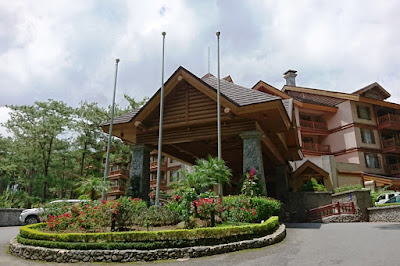 |
| The iconic facade of The Manor |
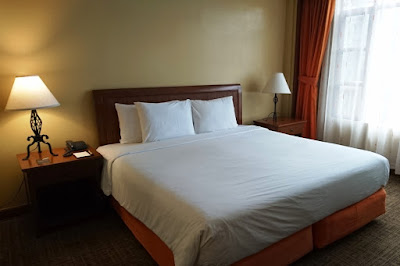 |
| The Manor's Superior Room overlooking the pine forest |
Read our review of the hotel: The Manor at Camp John Hay: The Ultimate Getaway in the Mountains of Cordillera
Since we booked a van service, getting around Baguio was never a problem for us. We would just tell our driver the places we want to visit and the things we want to do and in no time we'll be at our destination. Take note however that parking in Session Road or the market can be quite challenging so make sure to get a driver who is very familiar with Baguio.
Aside from having your own service, there are three other ways of going around the city - riding a jeepney, taking a taxi, or exploring on foot.
Just like anywhere else in the Philippines, riding a jeepney in Baguio is the cheapest option but can be tricky. There are no set schedules or route maps available to the public. So the most important thing to know is the route - where you're at and where you want to go. If unsure, ask the locals as they will be the ones most likely seasoned in commuting around the city. Riding the jeepney can also be inefficient. The process of filling up passengers and stopping every few meters to load or unload can eat up a lot of time in one's itinerary.
Taxis are available 24 hours and can be hailed along any relatively major Baguio street. These are identified with proper markings and white color. The current flag down rate is PHP35 with increments of PHP13.50 per kilometer and PHP2 per minute of travel time. It is not exactly cheap but it is more convenient and faster than riding a jeepney. Also, unlike in Metro Manila, drivers here will give the exact change. Some taxis can also be hired for an entire day of tour.
Walking can also be a great option while in Baguio. It is especially applicable in exploring places near each other. For example, you can walk from Baguio Cathedral to Session Road to Baguio City Market to Burnham Park. You can also walk from Baguio Botanical Garden to Wright Park to The Mansion. In fact, the region's Department of Tourism is also promoting walking in the city through its walk meters installed within the city's major parks. It indicates the distance to key locations and the approximate calories burned walking. It also aims to encourage a car-less community resembling the original plan of the city as a rest and recreation area.
Things to Do
1. Take a mandatory stop at The Mansion
Baguio, being the summer capital, houses a summer residence for the President of the Philippines. Aptly called The Mansion, this has been the official summer residence since the Commonwealth. It is located in the eastern part of the city along Leonard Wood Road.
The Mansion consists of an imposing Spanish Colonial Revival building and guest house. It was designed by William Parsons, the same architect of the Manila Hotel, in accordance with the City Beautiful Movement. Across the road is Wright Park, a quiet promenade with a long reflecting pool lined with pine trees.
 |
| The Mansion |
2. Catch the views at Mines View Park
As they say, you have never been to Baguio if you have not visited the Mines View Park. It might be teeming with tourists and filled with countless souvenir shops but it never gets old and remains a must-visit place.
Located on a land promontory 4 kilometers from the downtown, Mines View Park has an observation deck that offers panoramic views of the Cordillera mountain range, the abandoned gold mines of Benguet Corporation, and glimpses of the Amburayan Valley.
 |
| Mines View Park on a cloudy day |
3. Take a stroll around Burnham Park
Burnham Park is one of Baguio's beloved spots. It is a historic park located in the heart of the city. It was designed by Daniel Burnham, the original city planner of Baguio and the namesake of the park. It has various gardens and leisure areas interspersed between a man-made lagoon, an athletic bowl, and a grandstand.
Take a leisurely stroll around this beautiful urban oasis and do some recreational activities like boating, skating, or biking.
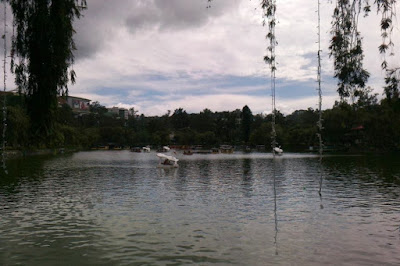 |
| Burnham Lake inside the park |
Although some say it's overrated, one should still find the opportunity to try Baguio's own version of the Filipino breakfast and snack favorite, the taho. Here, the taho, which is made of silken tofu topped with tapioca pearls, is sweetened with strawberry jam instead of the usual caramelized sugar syrup.
 |
| Strawberry Taho, perfect for sweet tooths |
5. Experience fun, thrill, and adventure at Tree Top Adventure Baguio
Experience zooming through the jungle canopy of the Cordillera mountains, or simply enjoy the cool Baguio weather as you take in as much of the breathtaking scenery as you can. These are definitely on the menu experience when visiting the Tree Top Adventure Baguio.
Located within Camp John Hay Special Economic Zone, this nature park brings all safety comforts while offering exciting nature tripping activities such as the Canopy Ride, Superman Ride, Silver Surfer, Tree Drop, and Trekking and Skywalk.
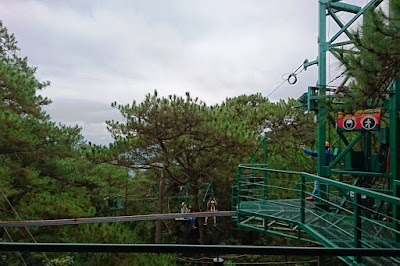 |
| Canopy Ride, one of the exciting attractions in Tree Top Adventure Baguio |
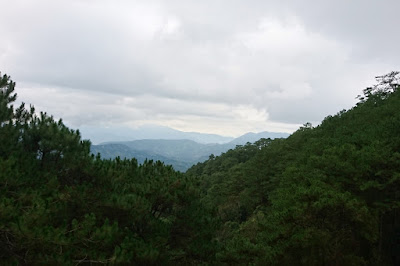 |
| Breathtaking views of the forest while on the Canopy Ride |
6. Be awed at the Bencab Museum
Although already located in the neighboring town of Tuba, Bencab Museum is a must in one's Baguio itinerary. It is a museum that is built on a promontory with a breathtaking view of a garden and the surrounding Cordillera mountains.
On the inside, Bencab Museum houses the permanent collection of National Artist for Visual Arts Benedicto Cabrera. The bigger galleries showcase his works ranging from paintings, drawings, prints, and sculptures. The smaller exhibits contain his collections of other local contemporary artists' works. There is also a gallery which houses artifacts and traditional art from all over the Cordillera region.
 |
| Bencab Museum by Benedicto Cabrera |
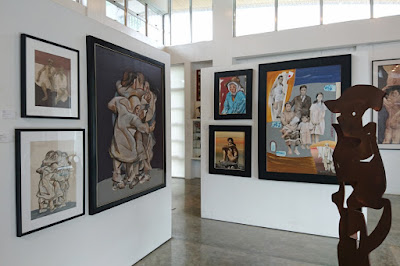 |
| Paintings and sculptures are some of the collections of Bencab Museum |
7. Go thrift shopping or ukay
Baguio has grown to become an ukay-ukay destination with streets filled with thrift stores left and right. Be warned though that there will be crowds to contend with and piles of old clothing to rummage through in finding rare and beautiful bargains. This may not be exactly an activity for everyone especially those who do not want to put in the work.
But for those who love ukay shopping, wander through the streets of downtown Baguio, hop from rack to rack, and you will find some great little treasures and designer finds to take home.
Where to Eat
With thousands of people flocking to Baguio all year round, naturally, there will also be thousands of food shops and restaurants to cater to the visitors' food cravings. From fine dining restaurants to hole-in-the-wall joints, there is something that will satisfy any taste or budget.
First, try out Le Chef at The Manor, considered as Baguio's best fine-dining restaurant. Reserve a table at the hotel's sprawling gardens to eat good food while enjoying great views and the cool mountain weather.
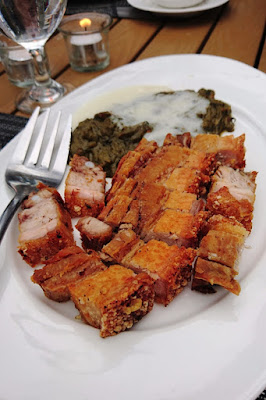 |
| Lechon Kawali with Spicy Laing |
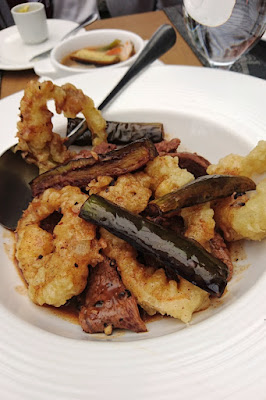 |
| Beef Steak Tagalog with Fried Aubergine |
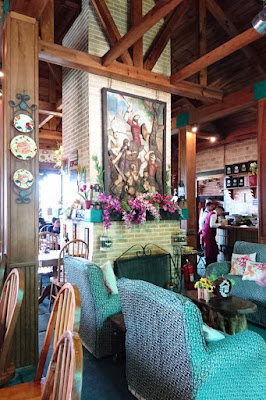 |
| The homey fireplace area of the Forest House |
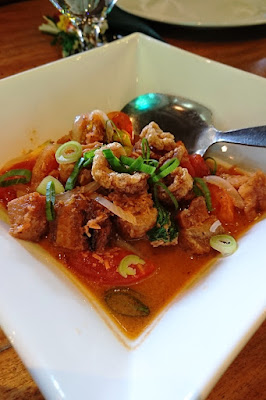 |
| Binagoongang Bagnet |
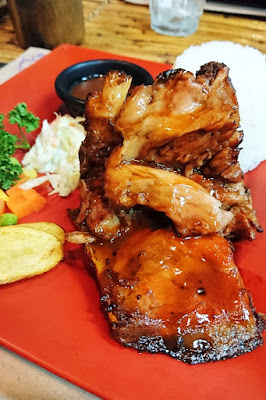 |
| The bestselling Little John's Baby Back Ribs |
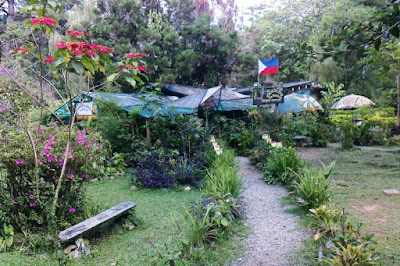 |
| The laidback and unassuming Choco-Late de Batirol |
There are a lot of cheap Baguio packages offered by travel agencies with prices starting from as low as PHP1,800 per person. For this trip, however, we went on an exclusive DIY trip and we splurged a bit. We spent approximately PHP4,150 per person for a 2D1N trip inclusive of the hotel stay in The Manor, meals at various restaurants, admission fees to attractions, and the round trip van service.
Note: This guide is designed based on our personal experience and we hope this is of use to Juans who plan to travel for the first time to Baguio.
Are you planning a trip to Baguio? Leave your questions below and we'll try to help out. If you find this useful, please share on social media. Thanks!

No comments:
Post a Comment